Here are the top five cassava processing machines for small businesses need to increase output, save time, and maximize profit, making smart choices for turning cassava into high-demand products efficiently.
If you’re running a small cassava business, the right machines can save you time, cut labor costs, and help you process more roots with less stress.
Whether you’re peeling, grating, pressing, or drying, each stage affects your final product and profit.
That’s why choosing the right equipment is not just helpful, it’s smart.
This guide breaks down the top five cassava processing machines that work well for small-scale setups.
These machines are not too expensive, easy to use, and built to handle the kind of work small businesses face every day.
You don’t need to guess or waste money trying out what may not work.
By the end of this post, you’ll know what to look for and how each machine fits into your daily cassava processing tasks.
Ready to step up your operation the right way?
Table of Contents
- 1. Cassava Peeling Machine
- 2. Cassava Grater or Grinder
- 3. The Cassava Press
- 4. Cassava Sifter or Sieving Machine
- 5. Cassava Dryer (Flash or Cabinet Dryer)
- Frequently Asked Questions
1. Cassava Peeling Machine
If you process cassava in large amounts, peeling by hand can slow you down and wear you out.
A cassava peeling machine takes that stress off your shoulders.
It strips off the thick outer skin quickly and gives you clean, smooth roots that are ready for the next step, whether you’re making garri, flour, or starch.
This machine cuts your peeling time and saves your team from the tiring, messy work of doing it all by hand.
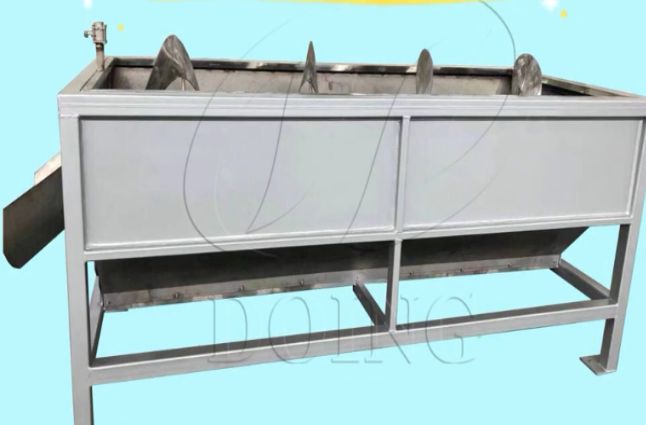
It also gives you consistent results, which means less waste and better product quality.
When choosing a peeling machine, think about how much cassava you handle daily.
You’ll want one that matches your production needs. Go for stainless steel if possible; it lasts longer and keeps your process clean.
And don’t forget maintenance. A machine that’s easy to clean and service will keep your work flowing with fewer interruptions.
Related Posts
- Cassava Flour Production for Business
- Cassava Business Plan Example
- Where to Buy the Cassava Chipper Machine
- How to Export Cassava from Africa
- How to Profit from the Cassava Value Chain
- What to Know Before Starting Cassava Farming
- Cassava Equipment That Saves Space And Labor
- How a Cassava Pressing Machine Improves Garri Production
2. Cassava Grater or Grinder
If you run a cassava business, the cassava grater or grinder is one machine you can’t skip.
Once the roots are peeled, this is the next key step. It crushes the cassava into a mash used for garri, fufu, or cassava flour.
The smoother and more consistent your mash, the better your final product will turn out.
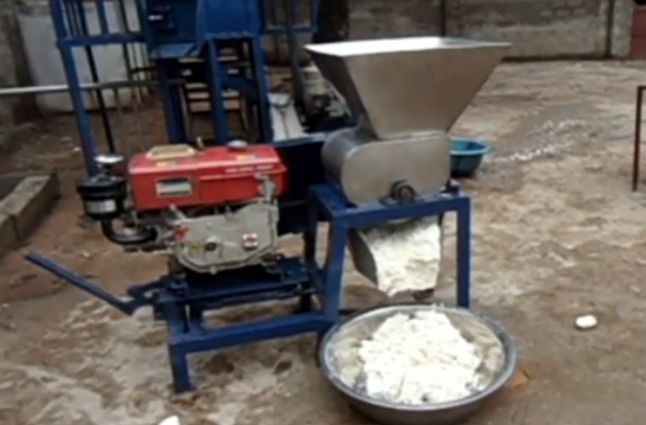
You can choose between manual and electric models. Manual graters are cheaper and don’t need power, but they take more time and effort.
Electric ones are faster, more consistent, and better if you want to process more roots daily.
When picking a grater, look at how sharp the blades are, how strong the machine is, and how easy it is to clean and use.
A good grinder should work well without draining power or breaking down often.
If you get this machine right, you’ll save time, reduce waste, and keep up with growing customer demand.
It’s a smart move for any small cassava processor.
Related: Top Manufacturers of Cassava Processing Equipment
3. The Cassava Press
After grating your cassava, the next step is pressing out the water, and that’s where a cassava press comes in.
This machine helps you remove excess moisture from the mash, which is key to making garri, fufu, and cassava flour that dries well and stores longer.
Without pressing, the fermentation process can go wrong and delay production. You can choose between two common types: the screw press and the hydraulic press.
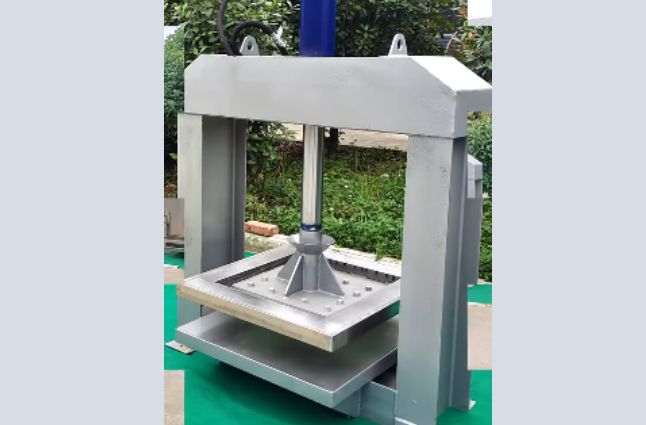
A screw press is more affordable, easy to operate, and doesn’t need electricity, but it takes more time and physical effort.
A hydraulic press works faster and gives you a more uniform press with less labor, which helps if you’re processing large batches.
When choosing, think about how much cassava you need to press each day, your budget, and power availability.
A good press saves you time, keeps your products consistent, and improves your workflow.
For a small business, this machine can make a big difference.
4. Cassava Sifter or Sieving Machine
Once your cassava has been dried or pressed, the next important step is sifting.
A cassava sifter or sieving machine helps you separate fine flour or starch from leftover fibers.
This step is key if you want smooth, clean products that meet what buyers expect, especially for cassava flour and starch used in baking or packaged foods.
Instead of sifting by hand, which can be slow and tiring, the machine does the job faster and with more accuracy. See a dedicated article on cassava sieving machine.
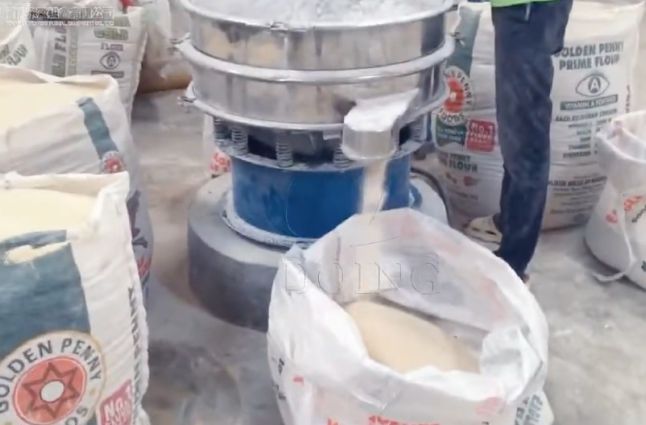
That means your final product has a consistent texture and fewer unwanted bits.
When choosing a sifter, look for one that comes with different mesh sizes so you can produce fine or coarse flour based on what your customers want. Also, think about cleaning.
A design that is easy to take apart and clean will keep things running without delays.
For small cassava businesses, a good sifter improves quality, saves time, and helps you stay competitive in the market.
5. Cassava Dryer (Flash or Cabinet Dryer)
Drying is one of the final and most important steps in cassava processing.
Without it, your products can spoil quickly or grow mold, especially in humid climates.
A cassava dryer helps you reduce moisture fast and safely, giving you clean, long-lasting flour, starch, or garri.
For small businesses, this means less waste and better product quality. You can choose between a flash dryer and a cabinet dryer.
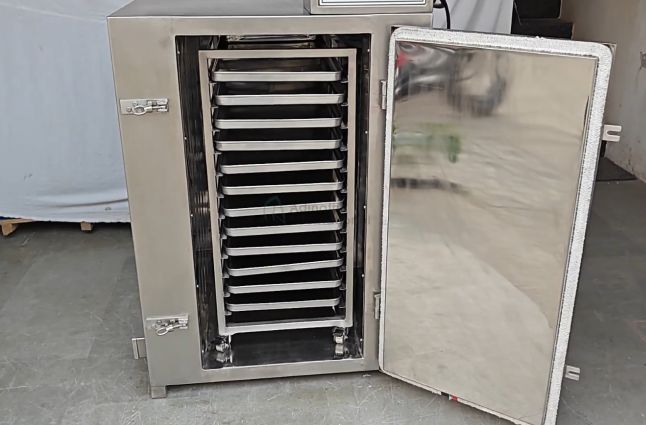
A flash dryer blows hot air through the wet cassava mash, drying it quickly. It’s a great option if you need speed and can process large volumes.
A cabinet dryer, on the other hand, uses trays and a steady heat flow for slower, more controlled drying.
It works well if you’re focusing on even results. When choosing a dryer, think about power.
If electricity is expensive or unreliable, solar-powered options can cut costs.
Also, look for dryers with temperature controls. That way, you can dry different cassava types properly without burning or under-drying them. More on cassava dryer machines here.
Frequently Asked Questions
What are the main types of cassava processing machines?
Cassava processing machines include graters, presses, dryers, sifters, and peelers. Each handles a specific task from raw root preparation to finished cassava products.
How do I choose the right cassava processing machine?
Focus on machine capacity, durability, power use, and ease of maintenance. Choose equipment that matches your production scale and keeps costs manageable.
What is the maintenance schedule for cassava processing machines?
Clean machines regularly, lubricate moving parts, and inspect for damage. Following the manufacturer’s maintenance guide helps avoid breakdowns and extends machine life.
Where can I purchase cassava processing machines?
You can buy cassava machines from online stores, equipment dealers, or trade fairs. Always check supplier reviews, warranties, and return policies before buying.
Are there any safety considerations when using cassava processing machines?
Yes. Train your team, use protective gear like gloves and goggles, and make sure machines have proper safety guards to reduce the risk of injury.
What are the five essential machines for cassava processing?
Peeling, grating, pressing, sifting, and drying machines are essential for turning raw cassava into high-quality products like flour, starch, fufu, and garri.
How much do small-scale cassava machines cost?
Prices vary by machine type and size. Manual options are cheaper, while electric versions cost more but save time and reduce labor.
Can I use these machines without electricity?
Yes. Some machines like manual graters and screw presses work without electricity, which helps in rural areas with unstable or no power supply.
Why should small businesses invest in processing machines?
Processing machines save time, reduce labor, and improve product quality. This helps small businesses scale production and stay competitive in local and export markets.
Conclusion
If you run a small cassava business, having the right machines can help you work smarter, not harder.
Each machine plays a specific role, from peeling to drying, and together they help you get better yields, cut losses, and serve your customers faster.
You don’t need the biggest machines, just the right ones that fit your scale, budget, and daily operations.
When you invest in quality equipment, you free up your time, improve your output, and set your business up for growth.
Start with what you can afford and grow from there. The right tools can turn your cassava roots into a strong source of income.

Chimeremeze Emeh is a writer and researcher passionate about Africa’s most transformative root crop—cassava. Through his work at cassavavaluechain.com, he explores the entire cassava industry, from cultivation and processing to its diverse applications in food, health, and industrial use.
He also writes for palmoilpalm.com, where he shares his extensive experience and deep-rooted knowledge of palm oil, covering red palm oil, palm kernel oil, and refined products. His work there reflects his lifelong connection to agriculture and his commitment to promoting sustainable value chains in Africa.
Driven by curiosity and purpose, Chimeremeze aims to shed light on how cassava continues to empower communities, strengthen food systems, and link traditional farming wisdom with modern innovation.

